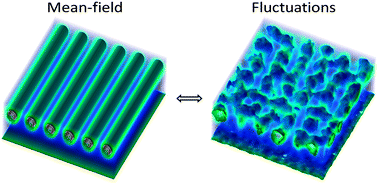Order–disorder transition in thin films of horizontally-oriented cylinder-forming block copolymers: thermal fluctuations vs. preferential wetting†
Abstract
We present experimental and theoretical investigations of the order–disorder transition (ODT) in thin films of cylinder-forming diblock copolymers with asymmetric wetting conditions. Grazing incidence small-angle X-ray scattering (GISAXS) was implemented to determine the ODT temperatures (TODT) for poly(styrene-b-2-vinyl pyridine) (PS-P2VP) block copolymer thin films on a P2VP-preferential silicon substrate. Specifically, films consisting of multilayers of horizontally-oriented cylindrical structures (from 1- to 9-layers) were tested. We find that films with more than 2 cylindrical layers have a TODT comparable to the bulk case. However, TODT decreases as the film becomes thinner and the monolayer system has an ODT 30 °C below the bulk. Using self-consistent field theory (SCFT), we studied the ordering in corresponding thin films with asymmetric (top and bottom surface) wetting conditions. Surprisingly, SCFT is found to predict an opposite trend in TODT with film thickness than observed experimentally. Field-theoretic simulations with complex Langevin sampling were employed to resolve this discrepancy and demonstrate that thermal fluctuations in the PS-P2VP thin-film system dominate its ordering behavior in monolayer and bilayer films.


 Please wait while we load your content...
Please wait while we load your content...